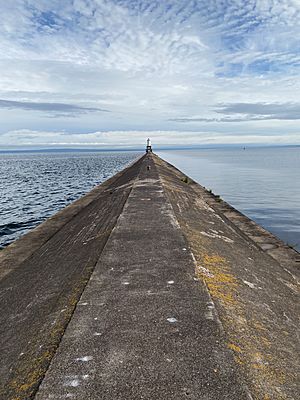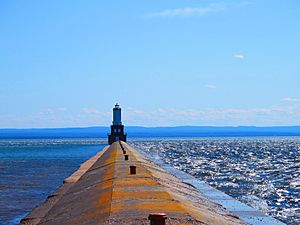Keweenaw Waterway Lower Entrance Light facts for kids
 |
|
| Near the start of the breakwater | |
|
|
|
| Location | S. end of breakwater at mouth of Portage R., Torch Lake Township |
|---|---|
| Coordinates | 46°58′8″N 88°25′52″W / 46.96889°N 88.43111°W |
| Year first constructed | 1919 |
| Year first lit | 1920 |
| Automated | 1973 |
| Construction | steel tower |
| Tower shape | octagonal |
| Markings / pattern | white w/ black lantern and red roof |
| Height | Tower - 62 feet (19 m) |
| Focal height | 68 feet (21 m) |
| Original lens | Fourth order Fresnel lens |
| Current lens | SABIK LED-350 two-tier lantern optic |
| Range | 9 nautical miles (17 km; 10 mi) |
| Characteristic | Fl White, 6 sec |
| ARLHS number | USA-418 |
| USCG number | USCG 7-14765 |
The Keweenaw Waterway Lower Entrance Light, also called the Portage Entry Light, is a lighthouse found at the end of a long wall (called a breakwater). This breakwater is at the mouth of the Portage River in Torch Lake Township. Lighthouses like this one help ships find their way safely. This lighthouse was added to the National Register of Historic Places in 2014, which means it's an important historical site.
Contents
History of the Lighthouse
Why Was a Lighthouse Needed?
The Portage River was first dug deeper in 1860 to help boats travel through. Soon after, people realized they needed a light to show where the river met the larger body of water. This would make it safer for ships.
In 1866, the government gave money to build the first lights here. These were called "range lights" and were finished in 1868. They helped ships line up correctly to enter the waterway.
Building the Breakwater and New Lights
The United States government bought the Keweenaw Waterway in 1891. After that, the U.S. Army Corps of Engineers started making big improvements. Their goal was to make it even easier for ships to navigate.
By 1898, a breakwater and a pier (a long structure extending into the water) were built here. These structures helped protect the entrance and guide ships.
At first, a wooden tower was put on the end of the pier in 1902 to hold a light. But it wasn't strong enough. So, in 1911, an iron tower replaced it.
The Modern Lighthouse is Built
In 1913, work began on a new harbor inside the waterway. To go along with these big changes, the government decided in 1917 to fund new navigation aids, including the lighthouse we see today. This new lighthouse would mark the very end of the entrance.
Construction on the current lighthouse began in 1919 and was finished in 1920. The special lens from the old pier light was moved to this new lighthouse. All the older lights marking the waterway's mouth were then removed.
Changes Over Time
The lighthouse became automated in 1973. This meant it could run on its own without people needing to be there all the time.
In 2010, the original old lens was replaced with a newer, more modern LED light. In 2014, the Coast Guard decided they no longer needed the lighthouse. In 2016, a group called the Keweenaw Waterway Lighthouse Conservancy was given ownership of the lighthouse. They now take care of it.
What the Lighthouse Looks Like
The Keweenaw Waterway Lower Entrance Light stands at the end of a long breakwater. This breakwater stretches out from the shore into the water at the mouth of the Portage River.
The lighthouse sits on a strong base made of wood and concrete. On top of this base is a concrete room, which used to hold the machinery for the lighthouse. Above this room is the main part of the lighthouse: a three-story, eight-sided steel tower. At the very top is the circular lantern room, where the light shines from.
The base of the lighthouse is a large, strong platform made of wood and concrete. It's about 32 feet wide and 50 feet long. On top of this platform is a concrete building. This building is about 25 feet by 25 feet and is 16 feet tall. It used to house the equipment that helped the lighthouse work.
The light tower itself is about 30 feet tall and is painted white. It has eight sides, making it an octagon shape. The very top of the tower is the lantern room. This is where the light is located. Inside, a modern LED light now shines, replacing the older lens. From the lantern room, there's a small walkway around the outside.
This lighthouse is a great example of how lighthouses were built in the Great Lakes area during the early 1900s.



